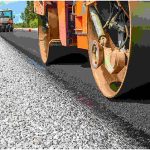Temperature Variations
Extreme temperature variations can causes severe pavement damage due to expansion, contraction and (in the case of rigid pavements) slab curling. Additionally, asphalt binder rheologyvaries with temperature. Therefore, estimated temperature extremes and their effects are a primary consideration. For flexible pavements, older asphalt binder grading systems did not directly account for temperature effects and thus various empirical systems and thumb-rules were developed. The Superpave PG binder grading system corrects this deficiency by grading asphalt binder based on its performance in relation to temperature.
Expansion and Contraction
Pavements, like all other materials, will expand as they rise in temperature and contract as they fall in temperature. Small amounts of expansion and contraction are typically accommodated without excessive damage, however extreme temperature variations can lead to catastrophic failures. Flexible and rigid pavements can suffer large transverse cracks as a result of excessive contraction in cold weather. Rigid pavements are also prone to slab buckling as a result of excessive expansion in hot weather (Figures 1 and 2).
 |  |
Slab Curling (Rigid Pavements)
Differences in temperature between the top and bottom surfaces of a PCC slab will cause the slab to curl. The weight of the slab and its contact with the subbase restrict its movement, thus, stresses are created. In 1935, measurements reported by Teller and Southerland of the Bureau of Public Roads showed that the maximum temperature differential (hence, maximum warping) is much larger during the day than during the night. Further, during the day, the upper surface of the slab is at a higher temperature than the bottom resulting in tensile stresses at the bottom of the slab.


